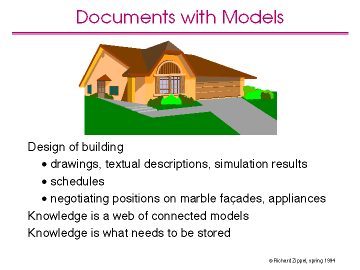
Back to the previous slide on to the next slide or up to the storage overview
Consider a ``document'' that captures the design of a building. Such a document contains construction plans of the building, floor plans, wiring and plumbing schematics, textual specifications of the image the building should project and three dimensional renderings of the building. In addition, for certain types of buildings, simulation and analysis results (e.g., to make sure that windows will not fall out) are included.
Added to this are schedules for delivery of building materials, availability of different craftsmen and financing, and negotiating positions for the purchase of all the exotic materials used. For instance, in a residential house the architect might specify a certain type of marble to be used in the entrance way if it is available at a ``good'' price, otherwise a cheaper granite might be a better choice.
Documents are in the business of representing knowledge. In the past books were the approach we most often used for representing knowledge. But today we have found that more complex structures can be useful. In principal, we feel that knowledge should be viewed as a web of connected models. The models can be as simple as a text file, or as complex as the three dimensional description of the shape of a building. In the end this web of models is what storage systems must be able to deal with. But storage systems must also deal with existing forms of data and allow for a smooth evolution from our current storage models to new models.
Richard Zippel